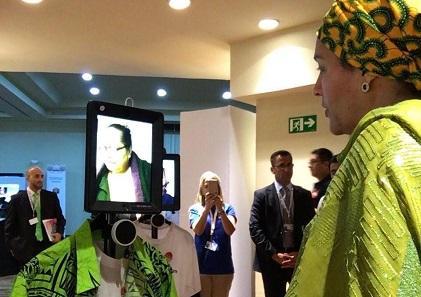
UN Deputy Secretary-General Amina Mohammed interacts with Lanieta Tuimabu, a board member of the Pacific Disability Forum, thousands of kilometres away thanks to the telepresence robot. (Photo: Catherine Naughton)
By Andrew McElroy
CANCUN, Mexico, 25 May 2017 – It may look like a gadget to many but this robot is a shining example of inclusive technology for disaster risk reduction.
The telepresence robot known as Double enabled the wisdom of 11 persons living with disability participating from the other side of the world in Bangladesh to be shared at the 2017 Global Platform for Disaster Risk Reduction.
The 15,000 kilometres from Dhaka to Cancun proved no barrier whatsoever as the Bangladeshis provided their insight and leadership at the resilient critical infrastructure session.
Another person who was ‘here’ – this time from 11,000 kilometres away in Suva, Fiji – was Ms. Lanieta Tuimabu, a board member of the Pacific Disability Forum.
“Sometimes technology is really amazing. It's great to be able to access the different sessions like this,” said Ms. Tuimabu, who has been visually impaired as a result of meningitis at the age of 12.
“It's the first time we've done it, and we were really eager to take up the opportunity. What's good is that we can also make our comments through the robot,” she said.
The Executive Director of the Institute on Disability and Public Policy (IDPP), Dr. Derrick Cogburn, said the use of such mobile remote presence devices at the Global Platform has "gone exceptionally well". Many perspectives of the "tremendously diverse and geographically distributed" global disability community had been incorporated.
“We have been exploring ways to use accessible information and communication technologies to enhance remote participation and active engagement in global governance processes such as the GP2017,” said Dr. Cogburn, who is also Associate Professor of International Communication, Development, Information Technology and Analytics, at American University.
“There has been very active engagement from our four remote hubs, Bangladesh, Fiji, Brussels, and Washington. It has been a superb example of what we can do in the future.”
UNISDR’s Senior Information Management Officer, Mr. Craig Duncan, said: “This is not about technology, and it is not about gadgets. This is about leadership in accessibility and inclusiveness in collaboration with network hubs of people living with disability from around the world.”
The robots have set an even higher benchmark of inclusion at a major global conference after the Third UN World Conference on Disaster Risk Reduction in Sendai, Japan in 2015 was heralded as the most inclusive ever.
Double Robotics, based in California, USA, launched ‘Double’ in May 2013. The company’s website says: “Double enables a revolutionary new level of interaction … it gives you a physical presence when you can’t be there in person.”
The Nippon Foundation has supported UNISDR and the IIDP to lead these remote participation efforts at the Global Platform.
Date:
26 May 2017
Sources:
United Nations Office for Disaster Risk Reduction (UNISDR)
Themes:
Civil Society/NGOs, Community-based DRR, Information Management, Vulnerable Populations
Countries:
Bangladesh
Regions:
Africa, Americas, Europe, Asia, Oceania